The Talon(February 2004)
By Tom Gaylord
© Copyright 2004 All Rights Reserved
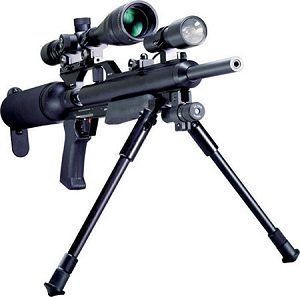
The Talon from AirForce Airguns is a revolutionary pellet rifle. Tactical styling, adjustable power, accuracy, reliability and easy owner maintenance are a few of the selling points for this U.S.-made precharged gun.
THE TALON AND TALON SS
These single-shot precharged air rifles use a detachable tank as the butt of the gun. They are highly modular, and the barrel can be changed in less than 10 minutes with just two Allen wrenches, so calibers and barrel lengths are owner-changeable on both airguns.
AirForce provides a free one-hour instructional video with every gun. It's a hands-on supplement to the owner's manual and shows most of the operational and maintenance procedures of the guns.

The Talon SS has a 12-inch barrel hidden inside the tubular frame. A special internal expansion chamber and muzzle cap dissipates a lot of the muzzle blast, making this gun quieter than its longer-barreled sibling. |
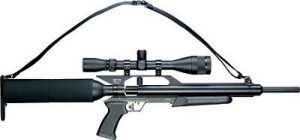
Though the regular Talon has the longer barrel, the tubular frame is actually shorter (look at the distance between the end of the forearm and the muzzle on both guns). An SS model fitted with an 18-inch barrel will not show the barrel, while a regular Talon with the short barrel and end cap will have almost no expansion chamber, rendering the sound suppression ineffective. |
The Talon has an 18-inch barrel, and the Talon SS has a 12-inch barrel with integral sound suppression. Both are available in .177 and .22 caliber.
The Talon has a short tubular frame, so the muzzle of the barrel sticks out a few inches past the end cap. The SS version has a longer frame to provide a deep cavity in front of the 12-inch barrel. The special SS end cap strips away the turbulent air as the pellet exits the end of the rifle and reduces the report. If you rebarrel an SS with an 18-inch barrel, it will not peek out past the end cap because of the longer frame, but the report won't be decreased. Though the SS is $20 more than the Talon, it can do everything the Talon can do in addition to being much quieter. I recommend buying an SS, then buying extra optional barrels for it.
Both rifles are made largely from aluminum, but, where necessary, as in the trigger mechanism, steel is used. A Talon weighs about 5.25 lbs. (5.5 for the SS) and can accept more accessories on its three rails than any other air rifle today. A Lothar Walther barrel in 12-inch or 18-inch length makes either rifle highly precise. A properly set-up rifle delivers a large number of shots within a very tight velocity spread. The removable air tank holds 490cc of air at 3,000 pounds per square inch (psi), making it a real leader in the number of shots per fill. Power is user-adjustable via an external thumbwheel on the left side of the tubular frame, and how many shots you get is based on the power setting. On a low setting, there may be more than 300 shots, while on the highest power the same gun may deliver 30-40 shots before a refill is required. Since the Talon/Talon SS is about one-third more powerful than many PCP air rifles sold today, such a high number of shots is pretty amazing. On a good plinking setting, a gun will deliver 60 to 75 shots.
This is the only precharged rifle on the market with a safety burst disk built into the air tank to prevent dangerous over-pressurization. Look for that feature to appear in other guns in the future, but Talons have had it for many years.
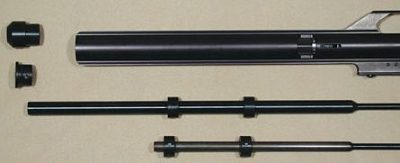
Owners can change barrels and even calibers in minutes. No other airgun offers this flexibility. A Talon SS frame is shown with both the 18-inch and 12-inch barrels and their respective end caps. Just remove four screws and either length barrel in either caliber may be installed. The two bushings on the barrel center it in the frame. |
POWER ADJUSTMENTS
As mentioned earlier, a thumbwheel on the left side of either rifle's frame adjusts the power. A marker indicates the major power divisions, while numbers on the wheel indicate minor steps. But don't think that the power actually increases and decreases by these exact amounts. Instead, there is a power range for each rifle. There is a lower limit of power, below which a particular rifle will not go unless other adjustments are made. That limit might occur when the power wheel is set at "4" on one rifle and "2" on another. Subtle differences in hammer-spring tension and the length of the adjustable valve stem, which is installed during manufacture, will affect the lower velocity limit. Also, the length of the barrel affects power.
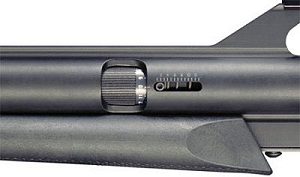
The power adjustment wheel is on the left of the receiver tube. The wheel has numerical divisions and one complete revolution of the wheel advances the round indicator on the right by one increment. The velocity actually increases along less discrete lines, but every gun is quickly adjustable by the shooter, which is something few air rifles can offer. |
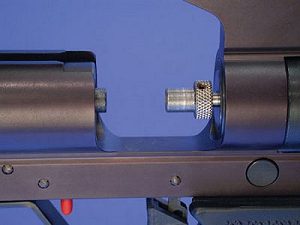
The valve stem (the top-hat arrangement on the right) has one or two Allen screws on the knurled circumference. Loosen them and screw the stem out for more airflow - in for less. This adjustment must be matched to the setting of the power wheel and the pellet in order to give optimum performance. |
Similarly, there is an upper limit to every gun. On a new Talon, it occurs around number "11," while a new Talon SS tops out somewhere between "9" and "11," with a shorter barrel causing the difference. Dialing the power to numbers above that limit simply exhausts more air without generating additional velocity. You're just wasting air.
Within the band of power adjustability, the Talon has a broad and useful range. I've had .22s shoot pellets reliably as slow as 450 feet per second (f.p.s.) and as fast as 950 f.p.s. Most Talon SS rifles I've tested range between a reliable low of about 600 f.p.s. and a high somewhere over 800 f.p.s. in .22 caliber. In .177 caliber, there's always a velocity increase. Of course, velocity depends on the pellet weight, too.
LET'S EXPERIMENT
The long-barreled Talon will shoot any given pellet faster than the SS, which is easy to check because you can swap barrels in minutes. In other words, turn an SS into a long barrel and vice-versa. You'll need a different end cap for the long barrel, but it comes with the optional barrel and that's all the difference there is. Say goodbye to quiet shooting with the longer barrel, though, as there is no sound suppression. Let's test a Talon SS with a 12-inch barrel.
Since the barrels swap so easily, I'll repeat the test with an 18-inch barrel on the same rifle. As you read the figures in the tables, remember that the only thing that I've changed is the length of the barrel.
.22-caliber Talon SS PCP rifle, 12-inch barrel length
Muzzle 1' from the start screen, 72F
All velocities in feet per second (f.p.s.)
Oehler 35P chronograph (all strings are 10 shots) |
| |
Talon SS set to the highest power |
.22-caliber
Shark hollowpoint
20.5 grains |
.22-caliber
Crosman Premier
14.3 grains |
| High |
763 f.p.s. |
850 f.p.s. |
| Low |
742 f.p.s. |
837 f.p.s. |
| Average |
749 f.p.s. |
845 f.p.s. |
| Extreme spread |
21 f.p.s. |
13 f.p.s. |
| Standard deviation |
6 f.p.s. |
4 f.p.s. |
| Muzzle energy |
25.54 ft.-lbs. |
22.68 ft.-lbs. |
|
| Talon SS set to the lowest power |
.22-caliber
Shark hollowpoint
20.5 grains |
.22-caliber
Crosman Premier
14.3 grains |
| 612 f.p.s. |
804 f.p.s. |
| 402 f.p.s. |
630 f.p.s. |
| 474 f.p.s. |
716 f.p.s. |
| 210 f.p.s. |
174 f.p.s. |
| 66 f.p.s. |
49 f.p.s. |
| 10.23 ft.-lbs. |
16.28 ft.-lbs. |
|
UNDERST UNDERSTANDING THE VELOCITY TABLES FOR THE SS
bles reveal a lot. First, notice the large extreme spread on low power with both pellets. That means this rifle's valve is not adjusted well for the lowest power setting. The hammer strike is too soft. By shortening the length of the valve stem, I can reduce the overall velocity. Plus, the extreme velocity spread will be much smaller. But, there may be a better setting on the power wheel for the rifle as it is set up right now. The velocity will vary less and the average velocity may actually drop if the velocity wheel is adjusted to a higher number. This seeming inconsistency is due to the fact that a better hammer/valve relationship will always produce tighter spreads. On the high end, our Talon SS is very consistent and you might think it's adjusted perfectly - but it's not. By adjusting the power wheel to a lower number, the high velocity remains the same, the maximum spread tightens and you use less air. The short barrel of the SS simply exhausts excess air at the maximum power setting. So, a chronograph is helpful; if you don't have one, carefully adjust the wheel above the number "11" and see by penetration whether the velocity is increasing or not. Otherwise, you can save your air and still enjoy maximum speed. While you can adjust the power wheel to get more consistency, you won't get the Talon SS to go much faster than these recorded numbers - the 12-inch barrel simply won't allow it. If you want to go faster, install the 18-inch barrel. Better yet, get the new optional 24-inch barrel. Finally, look at the differences between the heavy Shark hollowpoint and the light Crosman Premier. In both high and low velocities, the Premier has the tightest spread, though the Shark comes closer at the high end of the scale. With the current set of the valve stem, this rifle is optimally tuned for lighter pellets. Adjusting the length of the valve stem can change that. Keep in mind that heavy pellets always exhibit a large spread at the absolute lowest power wheel setting because their weight causes the valve to flutter.
.22-caliber Talon PCP rifle, 18-inch barrel length
Muzzle 1' from the start screen, 72F
All velocities in feet per second (f.p.s.)
Oehler 35P chronograph (all strings are 10 shots)
|
| |
Talon set to the highest power |
.22-caliber
Shark hollowpoint
20.5 grains |
.22-caliber
Crosman Premier
14.3 grains |
| High |
844 f.p.s. |
956 f.p.s. |
| Low |
827 f.p.s. |
931 f.p.s. |
| Average |
835 f.p.s. |
950 f.p.s. |
| Extreme spread |
17 f.p.s. |
25 f.p.s. |
| Standard deviation |
5 f.p.s. |
7 f.p.s. |
| Muzzle energy |
31.75 ft.-lbs. |
28.66 ft.-lbs. |
|
| Talon set to the lowest power |
.22-caliber
Shark hollowpoint
20.5 grains |
.22-caliber
Crosman Premier
14.3 grains |
| 506 f.p.s. |
732 f.p.s. |
| 376 f.p.s. |
600 f.p.s. |
| 433 f.p.s. |
671 f.p.s. |
| 130 f.p.s. |
132 f.p.s. |
| 40 f.p.s. |
37 f.p.s. |
| 8.54 ft.-lbs. |
14.30 ft.-lbs. |
|
UNDERSTANDING THE VELOCITY TABLES FOR THE TALON
What a difference six inches of barrel makes! The long-barreled Talon is more powerful at the highest settings with both pellets. But wait - it's LESS powerful with both pellets at the lowest setting. What gives?
What's happening at the lowest setting is that the pellet is using up the air before it reaches the end of the barrel. It starts coasting, and friction with the bore begins to slow it down. At the current valve stem setting, this rifle could use a bit more air at the lowest power wheel setting.
The long-barreled rifle is also more stable at the lowest setting with both pellets. That's probably got a lot to do with how long the pellet remains in the barrel to cause back pressure on the valve. At the lowest setting, the valve receives only a light tap from the hammer and may be fluttering on its seat a little. The additional back pressure caused by the pellet remaining in the barrel for a longer time may help seat the valve again.
The long-barreled rifle loses all sound suppression, of course, so it's much louder than the SS. You have to set up your rifle for what's important to you - maximum power or quietest operation. By comparing both tables - the SS and the long-barreled rifle - you can see that there is a generous middle ground where both guns perform the same, though possibly with different power wheel settings.
CALIBERS
Both versions come in either .177 or .22, but .22 is the better seller so far. A good strategy might be to initially buy a .22, then add a .177 barrel at some time. Or, if you want the .177 first, at least you know that .22 is always an option. Whatever you decide, changing barrels in the Talon is about as hard as installing a license plate on a car. I timed myself changing from short to long barrels, and it took 5 mins., 43 secs.
SETTING UP THE TALON
After unpacking your rifle, you'll want to get it into operation right away. AirForce ships every new rifle with a one-hour VHS video explaining the operation of the gun, how to fill it, how to sight in, barrel changes and so on. Watch the video before you try to set up your rifle, because it tells you everything. I'll cover the most important subjects now.

With the AirForce refill clamp, you can attach the butt tank to a scuba tank for filling.
Always go slow with scuba tanks because of heat buildup from the compression of air as the small tank fills. Too much heat can ruin O-rings and seals. Allow about a full minute to refill a tank or gun, even when going from 2,000 psi to 3,000 psi. |
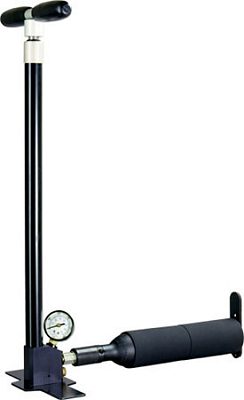
A manual pump fills the rifle's tank much slower than a scuba tank. It takes about 75 pump strokes to raise the pressure in the Talon tank from 2,500 to 3,000. That's about 15 pump strokes per 100 pounds of pressure increase. |
First, you need to put air into the tank. The tank is completely empty when you buy a new rifle, as it must be to be shipped to your house. This is the last time it will be empty, though. Once you fill it, don't let the air tank be empty again. Keeping at least a small 1,500 psi charge helps preserve the seals. Of course, you can keep it fully charged to 3,000 psi all the time with no problem. The only hurtful thing to this air tank is to remain empty. The one exception to this rule is that you must empty the tank before shipping it. Once your gun is filled, attach the tank to the rifle. It's time to shoot!
THE FEEL OF THE RIFLE
How does it feel to shoot a Talon? "NEAT!" It's more like shooting a fine rimfire rifle than any spring-piston air rifle can ever be. Some shooters have difficulty getting their eyes down low enough to acquire the scope because of the straight lines of the butt/tank, but the solution for that is a higher mount. The new B-Square ultra-high AA mounts should raise the scope high enough for almost anyone. AirForce now offers a Tri-Rail scope mount base that lifts most non-adjustable scopes up to the right height. Plus, with the Tri-Rail, you gain two additional mounting rails for more gear!
The trigger is not adjustable, but it's pretty nice as it comes from the factory. AirForce has made a multi-lever unit that has a two-stage pull with a nice, crisp letoff. My rifle repeatedly breaks at 34 oz. with no hint of creep.
The Talon holds more like a submachine gun than a single-shot rifle, and I think that colors many people's expectations. They see it as some kind of Rambo-style gun, and they expect to shoot it like an M16. AirForce advertising promotes this feeling by hanging every trick accessory they can think of on the rifle's plentiful accessory rails. Some are fanciful, but there is one you really need. The AirForce lightweight bipod is a treat on this gun. The increase in shooting stability is worth the few extra ounces it adds.
ACCURACY
In either barrel length, the Talon is wonderfully accurate. I personally like the SS better, because I like to shoot heavy Kodiaks at around 750 f.p.s., which my SS will do at a power setting of "10."
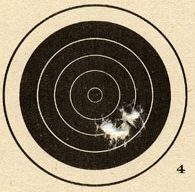
Kodiaks at about 750 f.p.s. are just right for the Talon SS. Five went through this 0.263-inch group at 35 yards. |
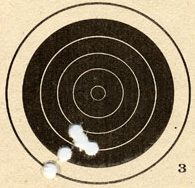
Shark hollowpoints are another "wedding-ring" pellet. Five made this 0.408-inch group at 35 yards. |
I often use the phrase "wedding-ring accuracy" to describe the Talon and Talon SS. By that phrase I mean five Beeman Kodiaks will easily pass through a wedding ring at a given distance. My ring is size 12 and the smallest group shown here measures 0.263 inches across the widest point. This was easy to obtain on a calm day at 35 yards. Five Shark hollowpoints grouped in 0.408 inches at the same distance. They punch cleaner holes because of a sharp forward shoulder - and fit neatly inside my wedding ring.
JSB Exact pellets work well, too. Shooters say the longer-barreled Talon is great out to 50 yards and beyond, but I haven't tested it that far. At 40 yards, it seems to keep pace with the SS, though at a much higher power level.
I've tested the new 24-inch barrel, which makes my Talon shoot alongside an accurized Ruger 10/22 at 50 yards, but only on a day when the wind is dead calm.
SUMMARY
The Talon and Talon SS air rifles are the most innovative airguns on the market. What other guns allow the shooter to change caliber in five minutes? What other gun gets over 300 shots on low power? What other precision adult airgun is made here in the U.S.? These aren't just air rifles, they're shooting systems that will grow and change with their owners for many enjoyable years.









